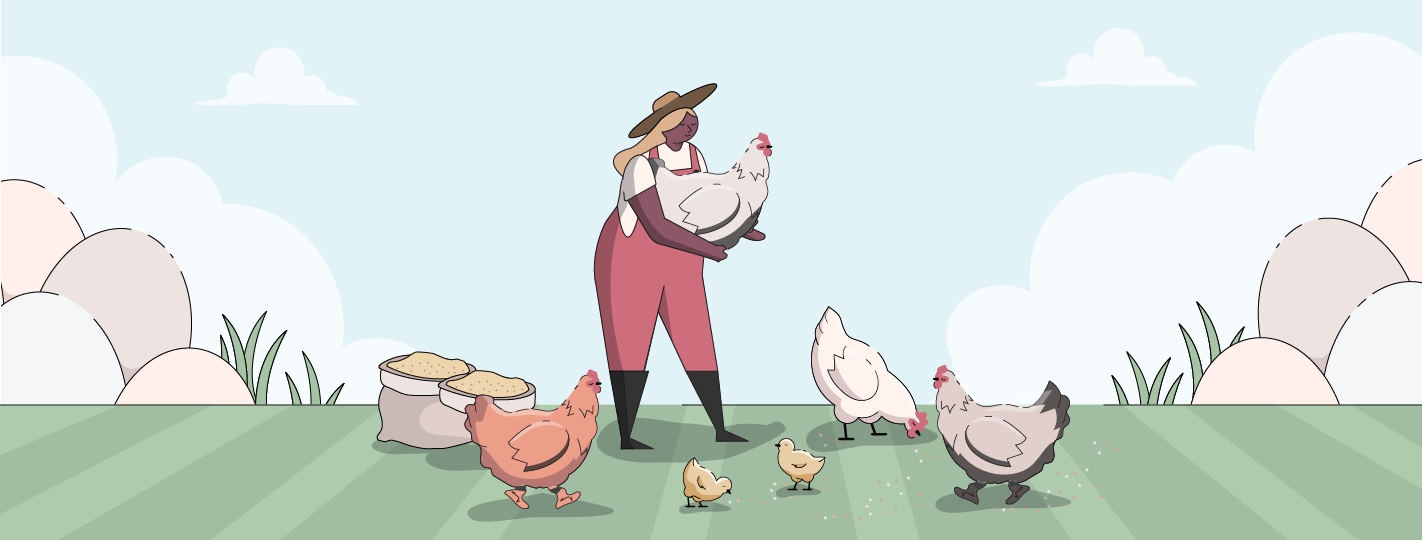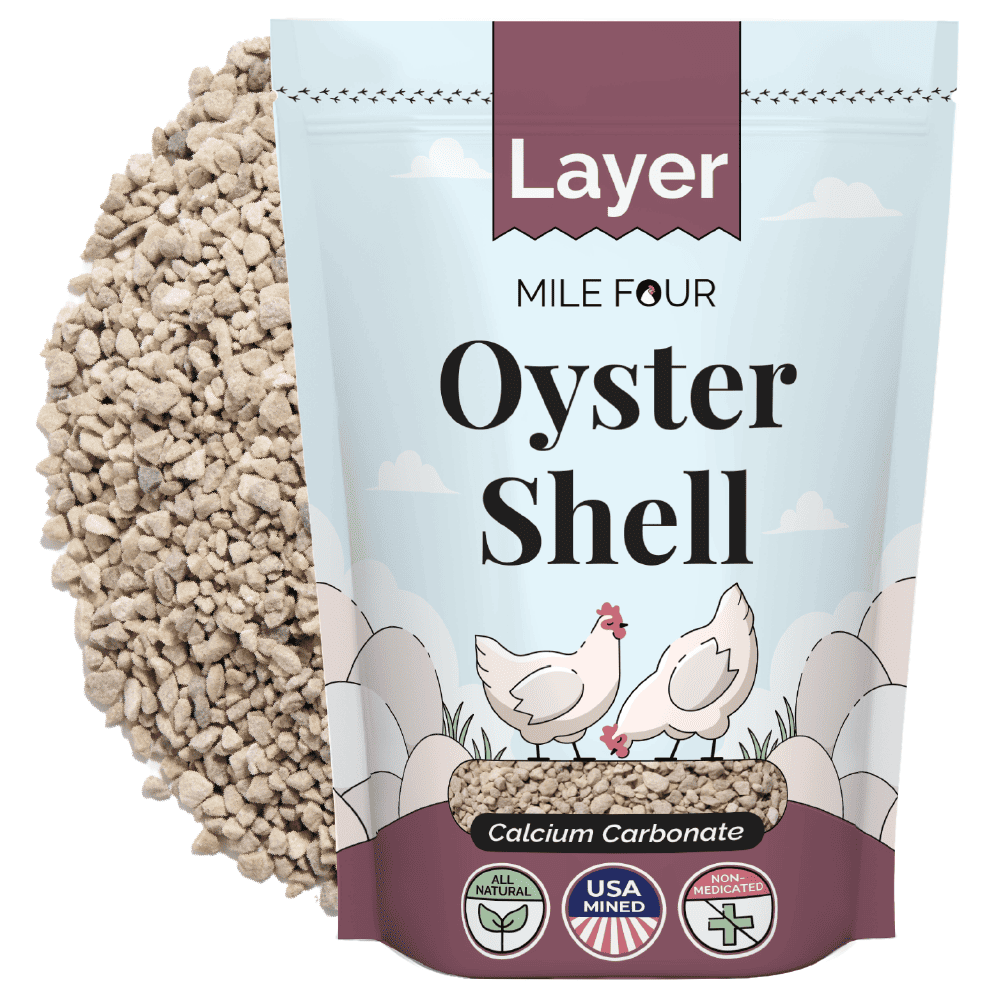Despite their uncertain lineage of the Brahma chicken, so much else is in fact known about them!
Brahma chickens were part of “hen fever” which was an obsession with poultry across the United States and Britain in the mid-1800’s, a period of history where many were obsessed with breeding and showing their hens.
Queen Victoria was said to have started the craze with her Cochin chickens, and many birds were being sold for up to $10,000 in today’s money!
Read on and we’ll tell you all about the Brahma Chicken!
Brahma Chickens
Quick Chick(en) Facts
| Origin |
Uncertain lineage. The likely parent birds were Shanghais, Chittagongs & Malays |
| Colors | Dark, light & buff |
| Weight | 8 - 10 lbs. |
| Lifespan | 5 - 8 yrs. |
| Rate of Lay/yr | 150-240 eggs |
| Egg size | Large |
| Egg Color | Brown |
| Heat Hardy | Somewhat |
| Cold Hardy | Yes |
| Broodiness | Frequently |
| Disease Susceptibility | Highly resistant if kept vaccinated |
| Temperament | Docile, friendly |
| Beginner friendly | Yes |
| Cost to purchase | $3-$10/chick |
Quick Jump
Chapter 1: Appearance of Brahma Chickens
Chapter 2: History of Brahma Chickens
Chapter 3: Brahma Chickens for Sale
Chapter 4: Brahma Chicken Egg Laying
Chapter 5: Brahma Chicken Health Issues & Care
Chapter 6: Brahma Chicken Temperament
Chapter 7: Feeding Brahma Chickens
Chapter 8: Coop & Run Size for Brahma Chickens
Chapter 9: Pros & Cons of Brahma Chickens
Chapter 10: Brahma Chicken FAQs
Chapter 1: Appearance of Brahma Chickens
Brahma Chicken Size
Despite once reportedly being as big as 14 lbs. as hens, Brahma chickens now weigh around 8 - 10 lbs.
Their size lends itself well to meat bird production, but Brahma’s are also well known as friendly, happy members of any backyard flock!
Brahma’s are wide and quite stocky, meaning they’ll likely be the biggest member of your flock.
This also means they’re very unlikely to escape, but they won’t want to, especially if you have the treats handy!
You may want to reconsider bringing a Brahma chicken or five into your home if you feel your coop is too small. These birds are pretty big! They’ll need more space than your average hen, so make sure you’ve measured and re-measured before purchasing one.
Colors
Officially, the Brahma comes in three different colors:
We say officially because these are the only three that the American Poultry Association recognizes, but there are more!
Namely the gold partridge and blue exchequer, but with these colors in so little numbers, their popularity simply isn’t enough for them to be recognized by the APA.
All Brahma chickens will have black tails, regardless of their official color, with the buff Brahma having (you guessed it) buff laced feathers on its tail.

Share this Image On Your Site
Chapter 2: History of Brahma Chickens
As we mentioned earlier, the history of the Brahma chicken isn’t very well known, but we do know that they were developed in the United States.
This was through cross breeding of Shanghai Fowl from China with Chittagong Fowl from India.
This cross breeding is what gives the Brahma chicken its pea comb, a distinctive feature.
Brahma Chickens Journey
The Brahma Chicken started its journey in the United States, and has bounced between England and the U.S. ever since.
Multiple Brahma’s were sent to Queen Victoria of England as a gift in the 1850’s.
From there, English breeders were able to develop the Dark Brahma variety from the nine chickens that were sent to her.
These Dark Brahma’s were then exported back to the United States, and eventually accepted into the APA’s Standard of Perfection in 1874.

Share this Image On Your Site
Chapter 3: Brahma Chickens for Sale
Brahma Chicken Hatcheries
Unlike some breeds, there doesn’t seem to be any hatcheries that specialize in Brahma Chickens themselves.
With that being said, they’re relatively common and can be found at most hatcheries online and across the United States.
At the height of their popularity, Brahma Chickens were known to go for more than $100 each, but you’ll be glad to find out that they have come down dramatically in price since then.
At Cackle Hatchery, Buff Brahma’s are $4.05 per bird if you buy between one and nine. The prices come down the more you buy!
If you do plan on welcoming Brahma’s into your flock, there are certain things you’ll need to consider before you do.
Is there enough space inside the coop? Remember, these are some big birds. They need around double the space of the average chicken.
Is your yard mostly dry? Brahma’s thrive in dry climates as their feathered feet won’t get muddy and stuck together.
Will you get them vaccinated? Despite being quite hardy chickens, they are still susceptible to some diseases, as well as lice & mites. Taking care of their medical needs is vital when owning them.
Chapter 4: Brahma Chicken Egg Laying
Previously used predominantly as a meat bird, Brahma Chickens are now well known for their eggs.
Heavier than a typical chicken’s eggs, they weigh in at around 24 ounces per dozen, and are a light(ish) brown color.

Share this Image On Your Site
Brahma Chicken Rate of Lay
Despite being kept mostly as an egg-laying chicken, the Brahma’s are lower on the list in terms of rate of lay.
A Brahma Chicken will generally lay around 150 eggs a year, or somewhere between two and three a week.
The biggest draw for these eggs are their size, which will usually always be bigger and more colorful than a store bought egg.
Brahma Chicken Broodiness
Brahma chickens aren’t any more or less broody than your typical chicken. Certainly not at the level that silkie chickens are.
Generally, it depends on the individual chicken on how often they go broody, but you will see an uptick in broody brahma’s if another chicken in your flock decides to go broody.
Brahma’s are quite well known for making great mothers to their young (and other chicks in the flock too).
If you have a flock consisting of Silkie’s, Polish and Brahma’s, your hatched chicks are going to be very well looked after!
Chapter 5: Brahma Chicken Health Issues & Care
Despite being quite hardy as a breed, the Brahma chickens can be somewhat susceptible to certain things that you’ll have to look out for as an owner.
Because of their size, they won’t be able to fly very high, meaning they’ll need a low perch. If their perch is set too high, they can hurt their feet when jumping off, which can cause bumblefoot.
If you suspect that your chicken might have Bumblefoot, you’ll have to isolate them from the rest of the flock while you treat them.
There are certain ways to treat Bumblefoot at home, but if your vet has experience with poultry, it might be best to take them there.
Bumblefoot isn’t contagious, but it can cause staphylococcus, which is contagious, so you’ll want to treat it early.
It will require an antimicrobial treatment, and often also requires antibiotics.
For first time chicken owners, the procedure can be daunting, so if you have access to an avian vet, we’d recommend you take your chickens there.
Because their feathers are so dense, you’ll need to watch out for lice and mites, especially in the colder, wetter months.
The wet mud can stick to the feathers around their feet, and when it dries it will clump together and cause issues like frostbite if it gets too cold.
This can be remedied by regularly cleaning your Brahma’s feet with epsom salt and/or a disinfectant solution that is non-irritable.
Keeping your chickens up to date on their vaccinations will also give you the best chance of success in keeping them alive for the longest time possible.
Vaccinations for Newcastle Disease and Infectious Bursal Disease, as well as deworming every eight weeks will ensure optimal health for your Brahma chicken.
Chapter 6: Brahma Chicken Temperament
Brahma chickens are known for their docile and friendly nature. If you spend time with them as chicks and pullets, they’ll love you forever!
It’s pretty common that your Brahma’s will eat out of your hands and even hop up into your lap for a cuddle.
They’re also very happy in a mixed flock. Never an instigator, they’ll get along with your other chickens just fine.
As previously mentioned, they make great mothers as well.
It’s not uncommon for them to “adopt” chicks from the flock that may not have a mother figure.
Similarly to the Silkie, they’ve been known to steal eggs from birds who have less of a tendency to go broody, and sit on them themselves.
Brahma’s are also pretty quiet, even the roosters!
You won’t hear much noise from them during the day or night, so if you’re worried about your neighbors making a noise complaint, the Brahma might be the way to go!
Brahma Chickens in the Pecking Order
Since Brahma chickens are quite docile and loving birds, they won’t be very high up in the pecking order of your flock.
Despite their size, it’s likely that they will be subordinate to birds who are more assertive, whether they’re smaller than the Brahma or not.
They’ll settle quite well into a healthy middle ground in the pecking order, and won’t show any desire to move up from there.
Chapter 7: Feeding Brahma Chickens
Brahma chickens don’t have any specific dietary needs, meaning you’ll be fine feeding them what you feed the rest of your flock.
Chicks will need a 21% Starter Feed, which you can purchase right here! They will eat Starter from the day they’re born to when they’re 8 weeks old.
Once they’re 8 weeks old, you’ll want to switch them to a 18% Grower Feed, which you can also purchase right here!
Grower is fed to pullets from 8 weeks all the way up to when they lay their first egg.
You may be feeding your Brahma’s grower feed for longer than you anticipate, but this is normal.
Brahma’s are notoriously late bloomers, and won’t lay their first egg until they’re six or seven months old.
Be on the lookout for their first egg right around this time frame.
Once their first egg is laid, you’ll need to switch them to a 16% Layer Feed.
You guessed it. You can purchase Layer Feed right here!
This Layer Feed will be the main source of nutrition for the rest of their lives, but you can add in treats like Scratch, or Oyster Shell to aid in egg production.
Something you may not consider when getting a Brahma chicken is that because they’re twice as big as most other chickens, they’ll generally eat twice as much.
This means you’re likely going to be purchasing a lot more feed than you’re used to.
For these reasons and more, it’s definitely a good idea to make sure you can afford a Brahma chicken before you welcome one into your flock.
Chapter 8: Coop & Run Size for Brahma Chickens
Brahma’s are pretty big birds, remember?
If you build your coop with an average chicken in mind, you may need to reevaluate.
Each brahma will need at least 4 square feet of space inside the coop, but any extra space you can allow them would make their lives that much happier, as well as healthier.
Of course, if your coop is larger, the nesting boxes will need to be larger as well.
Ensuring that the nesting boxes for your Brahma’s are at least twice the size of all other nesting boxes in your coop will provide them with enough space and keep them comfortable.
Your coop will want to be at the highest point of your yard so that water can drain away from it. The last thing you want is for the coop and run to be a mud pit.
They’ll need some space to roam, too, so outside of having a bigger coop, you’ll need a yard outside of that.
They can’t fly any higher than three or four feet, so a six-foot fence will be more than enough to keep them in.
Of course, all of this costs time, money and resources.
If you feel that you’re not yet ready to make these changes, it might be best to opt for a different, smaller breed.
Chapter 9: Pros & Cons of Brahma Chickens
| Pros | Cons |
| Docile, loving & friendly | Eat twice as much as the average chicken |
| Make great mothers | Susceptible to mites & lice |
| Large eggs | Can go broody often |
| Cold hardy | Feet can get irritated if not regularly cleaned |
| Won’t fly any higher than 3-4 feet | Will need to make coop, run & nesting boxes larger |
| Love to snuggle | Takes longer for them to start laying eggs |
Chapter 10: Brahma Chicken FAQs
Q: How many eggs will a Brahma hen lay per year?
A: Around 150-175 per year
Q: What color are their eggs?
A: Brown
Q: Are Brahma chickens aggressive?
A: No, they’re docile, friendly and very loving
Q: How often do Brahma hens go broody?
A: Brahma’s can go broody quite often, and make great mothers
Q: Are Brahma chickens susceptible to any diseases?
A: Because of their feathery feet, they can be susceptible to mites and lice, but keeping them clean, as well as up to date on their vaccinations will keep them as happy and healthy as they can be
Summary
Overall, you’ll be extremely happy upon welcoming a Brahma chicken into your flock.
They’re friendly, loving chickens that aren’t aggressive to other members of the flock.
They also make great mothers, and can even hatch eggs that other chickens do not want to sit on.
You will need to ensure that you have enough space for them, however, as well as enough feed, since they eat twice as much as the average chicken.
You’ll also need to spend the time cleaning and drying their feet, while ensuring their space stays dry too, so that they don’t struggle with foot issues.
Keeping on top of their vaccinations and deworming is also vital to keep your Brahma happy and healthy.
If you think you can handle these things, get a couple of Brahma Mama’s during chick season and you’ll never look back!




![Winter Chicken Care | Ultimate Guide [2025]](http://milefour.com/cdn/shop/articles/Mile_Four-Content-15_e1067340-1a72-4632-83f5-c66d9a2158d9.png?v=1765974101&width=1500)





2 comments
I have a nice flock of Brahmas. Their eggs are quite large and sometimes I get a super jumbo egg, more than 3oz. I’m just wondering why this is not consistent. I feed a high protein lay pellets and get get to get out and free range. What makes an occasional egg so large? Can I put them a different feeding program that will produce all eggs so large?
I have a nice flock of Brahmas. Their eggs are quite large and sometimes I get a super jumbo egg, more than 3oz. I’m just wondering why this is not consistent. I feed a high protein lay pellets and get get to get out and free range. What makes an occasional egg so large.